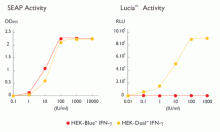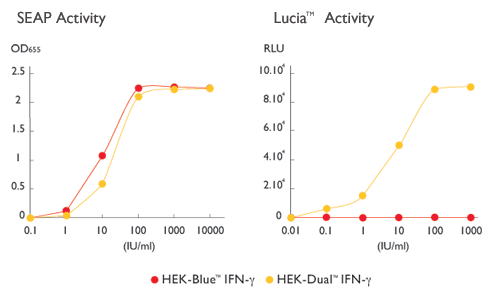IFN-γ Reporter HEK 293 Cells
| Product | Unit size | Cat. code | Docs. | Price | |
|---|---|---|---|---|---|
|
HEK-Dual™ IFN-γ cells Human IFN-γ SEAP/Luciferase Reporter Cells |
Show product |
3-7 x 10e6 cells |
hkd-ifng
|
Human Interferon-γ Reporter Cells

HEK-Dual™ IFN-γ Cells signaling pathway
HEK-Dual™ IFN-γ cells allow the detection of bioactive human interferon-γ (IFN-γ) by monitoring the activation of the JAK/STAT-1 pathway by assessing the activity of two different reporters, SEAP (secreted embryonic alkaline phosphatase) or Lucia luciferase, a secreted luciferase.
IFN-γ, a Type II IFN, is a pleiotropic cytokine with anti-viral, anti-tumor, and immunomodulatory functions [1]. IFN-γ binds a heterodimeric receptor consisting of two subunits, IFNGR1 and IFNGR2, associated with JAK1 and JAK2, respectively. Upon binding to this receptor, IFN-γ triggers JAK/STAT signaling. Activated STAT1 molecules form homodimers and are translocated to the nucleus where they bind interferon-gamma-activated sites (GAS) in the promoter of IFN-γ inducible genes.
Cell line description:
HEK-Dual™ IFN-γ cells were generated by stable transfection of the human embryonic kidney HEK293 cell line with the human STAT1 gene to obtain a fully active STAT1 pathway. The other genes of the pathway are naturally expressed in sufficient amounts.
These cells were further transfected with two reporter genes, SEAP and Lucia luciferase, under the control of an IFN-γ inducible promoter. As a result, HEK-Dual™ IFN-γ cells allow studying the activation of JAK/STAT-1 pathway, by monitoring the activity of two different reporters, SEAP or Lucia luciferase.
Both reporter proteins are readily measurable in the cell culture supernatant when using QUANTI-Blue™ Solution, a SEAP detection reagent, and QUANTI-Luc™ 4 Lucia/Gaussia, a Lucia and Gaussia luciferase detection reagent.
Features of HEK-Dual™ IFN-γ cells:
- Fully functional IFN-γ signaling pathway
- Readily assessable SEAP and Lucia luciferase reporter activity
- Functionally tested and guaranteed mycoplasma-free
Applications of HEK-Dual™ IFN-γ cells:
- Detection of human IFN-γ
- Screening of anti-hIFN-γ antibodies
Reference:
1. Ivashkiv L.B., 2018. IFNγ: signalling, epigenetics and roles in immunity, metabolism, disease and cancer immunotherapy. Nat Rev Immunol. 18(9):545-558.
Back to the topSpecifications
Antibiotic resistance: blasticidin, Zeocin®, puromycin
Growth medium: DMEM, 4.5 g/l glucose, 2 mM L-glutamine, 10% (v/v) heat-inactivated fetal bovine serum, 100 U/ml penicillin, 100 μg/ml streptomycin, 100 μg/ml Normocin™
Guaranteed mycoplasma-free
- Detection range for human IFN-γ using QUANTI-Luc™: 1 - 10e3IU/ml
- Detection range for human IFN-γ using QUANTI-Blue™: 5 - 100IU/ml
These products are covered by a Limited Use License (See Terms and Conditions).
Back to the topContents
- 1 vial of HEK-Dual™ IFN-γ Cells (3-7 x 10e6 cells)
- 1 ml of Blasticidin (10 mg/ml)
- 1 ml of Puromycin (10 mg/ml)
- 1 ml of Zeocin® (100 mg/ml)
- 1 ml of Normocin™ (50 mg/ml)
- 1 ml of QB reagent and 1 ml of QB buffer (sufficient to prepare 100 ml of QUANTI-Blue™ Solution, a SEAP detection reagent)
- 1 tube of QUANTI-Luc™ 4 Reagent, a Lucia luciferase detection reagent (sufficient to prepare 25 ml)
![]() Shipped on dry ice (Europe, USA, Canada, and some areas in Asia)
Shipped on dry ice (Europe, USA, Canada, and some areas in Asia)
Details
Interferon-gamma (IFN-γ), a Type II interferon, is secreted from CD4+ T-helper 1 (Th1) cells and activated natural killer (NK) cells. It plays a role in activating lymphocytes to enhance anti-microbial and anti-tumor effects [1-3]. In addition, IFN-γ plays a role in regulating the proliferation, differentiation, and response of lymphocyte subsets.
IFN-γ exerts its action by first binding to a heterodimeric receptor consisting of two chains, IFNGR1 and IFNGR2, causing its dimerization and the activation of specific Janus family kinases (JAK1 and JAK2) [4, 5]. Two STAT1 molecules then associate with this ligand-activated receptor complex and are activated by phosphorylation. Activated STAT1 forms homodimers and are translocated to the nucleus where they bind interferon-gamma-activated sites (GAS) in the promoter of IFN-γ inducible genes.
1. Ivashkiv L.B., 2018. IFNγ: signalling, epigenetics and roles in immunity, metabolism, disease and cancer immunotherapy. Nat Rev Immunol. 18(9):545-558.
2. Shtrichman R. & Samuel CE., 2001. The role of gamma interferon in antimicrobial immunity. Curr Opin Microbiol. 4(3):251-9.
3. Sato A. et al., 2006. Antitumor activity of IFN-lambda in murine tumor models. J Immunol. 176(12):7686-94.
4. Platanias L.C., 2005. Mechanisms of type-I- and type-II-interferon-mediated signalling. Nat Rev Immunol. 5(5):375-86.
5. Schroder K. et al., 2004. Interferon-gamma: an overview of signals, mechanisms, and functions. J Leukoc Biol. 75(2):163-89.






